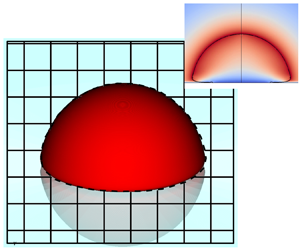Article contents
Direct numerical simulations of microlayer formation during heterogeneous bubble nucleation
Published online by Cambridge University Press: 12 April 2024
Abstract

In this article, we present direct numerical simulation results for the expansion of spherical cap bubbles attached to a rigid wall due to a sudden drop in the ambient pressure. The critical pressure drop beyond which the bubble growth becomes unstable is found to match well with the predictions from classical theory of heterogeneous nucleation imposing a quasi-static bubble evolution. When the pressure drop is significantly higher than the critical value, a liquid microlayer appears between the bubble and the wall. In this regime, the interface outside the microlayer grows at an asymptotic velocity that can be predicted from the Rayleigh–Plesset equation, while the contact line evolves with another asymptotic velocity that scales with a visco-capillary velocity that obeys the Cox–Voinov law. In general, three distinctive regions can be distinguished: the region very close to the contact line where dynamics is governed by visco-capillary effects, an intermediate region controlled by inertio-viscous effects away from the contact line yet inside the viscous boundary layer, and the region outside the boundary layer dominated by inertial effects. The microlayer forms in a regime where the capillary effects are confined in a region much smaller than the viscous boundary layer thickness. In this regime, the global capillary number takes values much larger then the critical capillary number for bubble nucleation, and the microlayer height is controlled by viscous effects and not surface tension.
Information
- Type
- JFM Papers
- Information
- Copyright
- © The Author(s), 2024. Published by Cambridge University Press
References
Saini et al. supplementary movie 1
- 7
- Cited by


